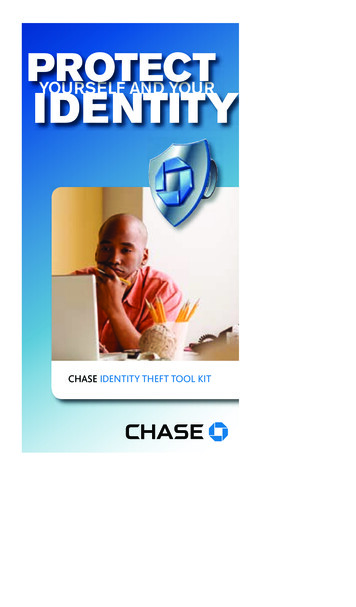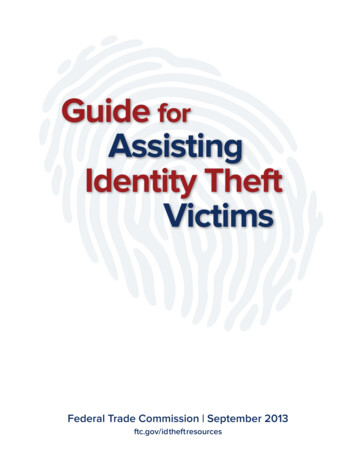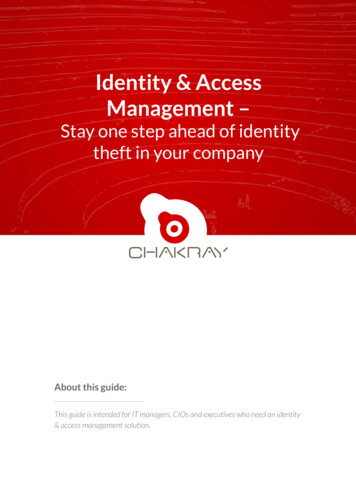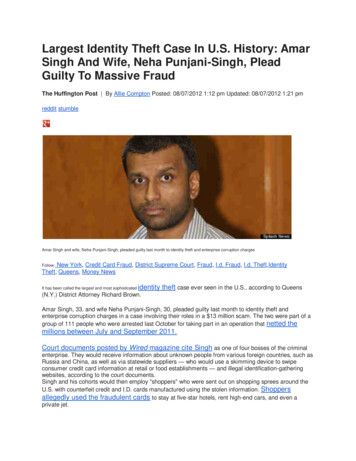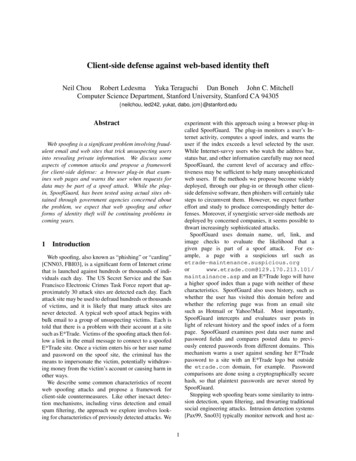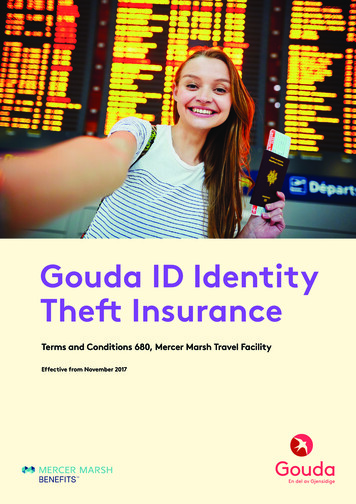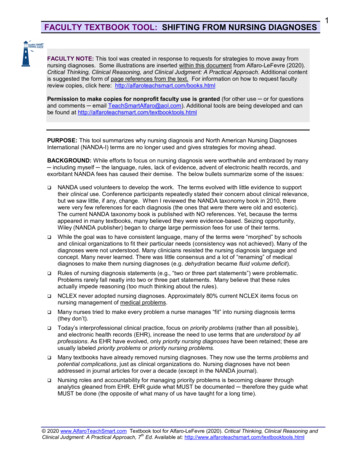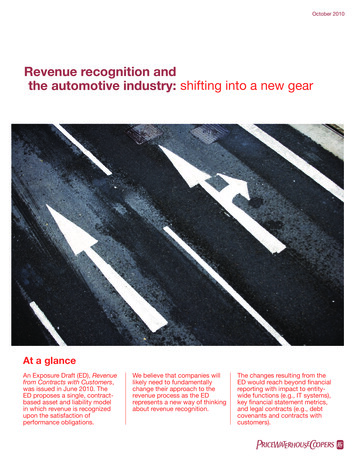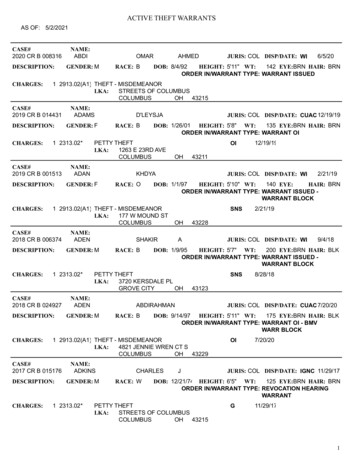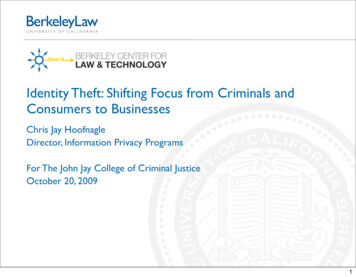
Transcription
Identity Theft: Shifting Focus from Criminals andConsumers to BusinessesChris Jay HoofnagleDirector, Information Privacy ProgramsFor The John Jay College of Criminal JusticeOctober 20, 20091
Thesis: identity theft as a business process problemOverview of discussion Costs of identity theft How credit authentication works (and fails) Negligent credit granting cases Synthetic identity theft Two methods of addressing identity theft FACTA Access Measuring identity theftImplications How should we allocate law enforcement resources? Should we adopt biometric or other more complex authentication systemsto prevent identity theft? Should we adopt national identification to prevent identity theft?2
What is identity theft?Identity theft is the knowing use of identification information of another tocommit any unlawful activity 18 USC §1028A fraud committed or attempted using the identifying information of anotherperson without authority 16 CFR § 603.2 (2006)3
Criminal prosecutions lowEstimated that 1 in 700 identity thieves are arrested by federal authoritiesGartner GroupAnecdotal pickup4
Two types of financial identity theftAccount takeovers (most identity theft)Thief takes control of an existing account. 67% credit card 19% checking/savings 9% telephone serviceNew account fraudThief establishes new lines of credit using personal information from thevictimSynthetic fraud: mixture of real and false personal informationOther variations not addressed hereCriminal identity theftIdentity cloning5
Account takeovers are more prevalentIdentity Theft Survey ReportFederal Trade CommissionQ1 / Q3a / Q4 – Incidence of Identity Theft, Past 5 Years100%80%60% 40%20%12.7%4.7%6.0%2.0%0%N e w accounts & otherfraudsO ther existing accountsExisting credit card onlyTotal victimization4.7% ofAmericanadults surveyedSource: FTC2003Report,Page 11said that within the last 5 years they had discovered thatthey were the victim of an Identity Theft that involved the opening of new accounts or loansor committing theft, fraud, or other crimes using the victim’s personal information (“NewAccounts & Other Frauds” ID Theft). (Approximately 65% of those who experienced “NewAccounts & Other Frauds” ID Theft within the last five years also experienced the misuse of6
But new account fraud higher costs to victimsIdentity Theft Survey ReportFederal Trade CommissionQ30 – Money paid out of pocket100%New accounts & other fraudsOther existing accountsExisting credit card only80%75%58%60%50%40%20%16%15% 16%15%12%8%8%6%3%0%NoneLess than 100 100 - 999 1,000 or moreSource: FTC 2003 Report, Page 43 For most victims of Identity Theft (63%), there was no loss of money out-of-pocket. Almost three-quarters of victims who only suffered the misuse of existing credit cardaccounts had no out-of-pocket losses. However, even for victims of the more serious kinds7
And lost timeSource: FTC 2003 Report, Page 458
How credit authentication works9
If there is no match.The credit grantor might ask for more information to get a good match orultimately reject the application“No hit:” SSN doesn’t match name, grantor may assume that the customerdoesn’t have a credit file at all Some creditors grant in no file situations10
Credit granting and the law - business regulationsCRAs are required to "maintain reasonable procedures designed" to preventunauthorized release of consumer information 15 U.S.C. § 1681e(a)California: in in-store, instant credit situations, 3 identifiers must match. First and last name, month and date of birth, driver's license number, placeof employment, current residence address, previous residence address, orsocial security number, but mother’s maiden name California Civil Code § 1785.14“Red Flags” Rule Must identify “patterns, practices, and specific forms of activity” associatedwith identity theft Must include reasonable policies and procedures for detecting, preventing,and mitigating identity theft11
Credit granting and consumer self-helpA user-initiated fraud alert requires "reasonable policies and procedures toform a reasonable belief that the user [credit grantor] knows the identityof the person making the request." Usu. means call to cell phone or password However, no contact w/ victim/impostor required No statutory penalty for ignoring the alert ITRC finds 19% of cases fraud alert is ignoredCredit Freeze requires the consumer to contact the CRA and “thaw” thereport, otherwise the credit grantor cannot obtain the report, andtherefore, cannot grant credit12
How credit auth. fails (the negligent granting cases)Matching SSN, but incorrect DOB, address thousands of miles away from thevictim Vazquez-Garcia v. Trans Union De P.R., Inc., 222 F. Supp. 2d 150 (D.Puerto Rico 2002)6 AMEX cards obtained using matching name and SSN, but all sent to theimpostors' home United States v. Peyton, 353 F.3d 1080 (9th Cir. 2003)Bank issued two credit cards based on matching name and SSN but incorrectaddress Aylward v. Fleet Bank, 122 F.3d 616 (8th Cir. 1997)Matching SSN but incorrect address Dimezza v. First USA Bank, Inc., 103 F. Supp. 2d 1296 (D.N.M. 2000)13
Wolfe v MBNA, 485 F. Supp. 2d 874 (WD. Tenn. 2007)MBNA telemarketer approves application with false address, phone #, relative. 21 year old student applicant with no job Application claimed 55k income MBNA: “Nothing was verified.”–(Plaintiff's Response in Opposition to Defendant MBNA's Motion toDismiss Fourth Amended Complaint)Court: case against MBNA may proceed on negligence! MBNA settles thecase!14
SSN Only Fraud?“Making purchases on credit using your own name and someone else's SocialSecurity number may sound difficult But investigators say it is happeningwith alarming frequency because businesses granting credit do little toensure names and Social Security numbers match and credit bureaus allowperpetrators to establish credit files using other people's Social Securitynumbers.” Lesley Mitchell, New wrinkle in ID theft;Thieves pair your SS number with theirname, buy with credit, never get caught; Social Security numbers a new tool forthieves, The Salt Lake Tribune, June 6, 2004, at E115
Synthetic identity theftUS v. Rose et al, CR06-0787PHK-JAT (VAM) (D. Az. 2006), indictment filedAug. 22, 2006.16
Real SSN, fake name, real address synthetic person17
How does synthetic identity theft work?Thieves know SSN structure 111-22-1234–555 (area number, geographically linked)–22 (group numbers, linked to issuance date)–1234 (serial number, unique)18
Thesis: identity theft is a business process problemThe negligent credit granting cases show that new accounts can be obtainedwith obvious errors on the applicationThe synthetic cases show that only the SSN and DOB need to be linked forcredit grantingMy hypothesis: Some credit grantors are authenticating applicants by“verifying” the SSN (matching the group number with date of birth).19
Testing the hypothesis: FACTA Access StudyThe FACTA (Fair and Accurate Credit Transactions Act of 2003) allows victimsof identity theft to obtain business records associated with the crime fromthe company that created an account for the impostor in the victim's nameThe goal of the FACTA Access Study is to discover the human factors anddecision making at businesses that have opened accounts to impostors.Through obtaining the business records in identity theft cases, we will beable to evaluate both business practices and defenses to identity theft20
Measuring identity theftParallels with motor vehicle safetyCan a market for preventing identity theft can be fostered among lendinginstitutions?Draws upon several sources of data FTC consumer complaint data FDIC bank statistics Proprietary ranking statistics21
Auto safety.not that long ago. It’s the driver’s fault,Focus should be on “drivereducation”Significant underinvestment insafetyDialogue suffered from a lack ofdata and understanding ofaccident physics22
Auto safety: nowIt’s the driver’s fault, butTesting, ratings availableData drives inclusion of newaccident mitigation, avoidancetechnologyA market for safety hasemerged, with once top-ofthe-line features appearing ininexpensive cars23
Federal Trade Commission consumer victim data24
Methods challenges150k complaints aggregated over three yearsAbout 275k reported a yearNo data on takeovers vs. new accountFTC database limitationsUnderreportingOnly 1 in 32 victims file a report with the FTCMisidentificatione.g. AT&TRetailer cases may be new account or takeover situationsSome banks forward complaints to the FTC automatically25
25 companies account for about 50% of incidents2008 (47.3% of all cases)2006 (48.4% of all cases)2007 (49.8% of all cases)BANK OF AMERICAAT&TCAPITAL ONECITIBANKIRSSEARSHSBCDISCOVERTMOBILECOMCAST26
Meaningful rates are difficult to create w/ current dataHSBCCAPITAL ONEGE MONEY BANKBANK OF AMERICAWELLS FARGO BANKDISCOVER BANKJPMORGAN CHASECITIBANKUS BANKAMERICAN EXPRESS20082007200627
Policy implicationsIdentity theft is a cost of doing businessBut externalities are imposed on the publicMight look to tax policy to address the externalitiesLoose authentication practices opportunities for improvement without lawenforcement resourcesRed flag rulesTargeted education to top 25 listFrees law enforcement resources for more intractable fraudsBiometric/National identification?Authentication problems still need to be fixed28
Questions?Chris Hoofnaglechoofnagle@law.berkeley.edu510.643.021329
of identity theft to obtain business records associated with the crime from the company that created an account for the impostor in the victim's name The goal of the FACTA Access Study is to discover the human factors and decision making at businesses that have opened accounts to impostors. Through obtaining the business records in identity theft cases, we will be able to evaluate both .
